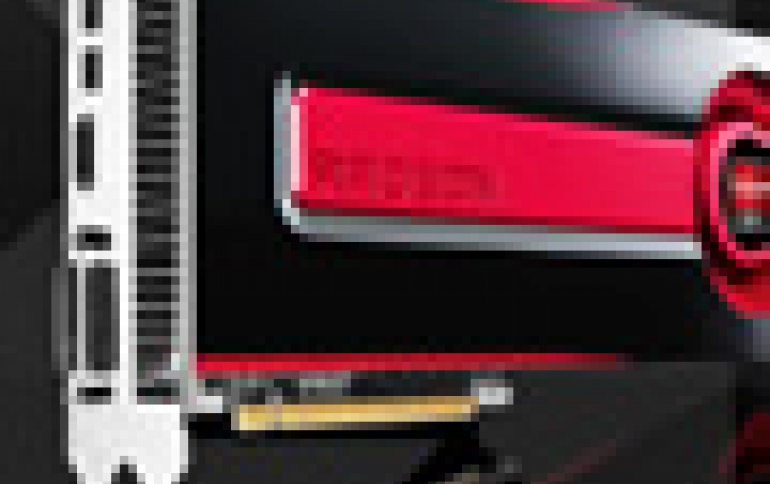
AMD Claims New AMD Radeon HD 7970 Is The World's Fastest Single-GPU Graphics Card
AMD today launched the AMD Radeon HD 7970 graphics card
for desktop PCs, in what the company describes as the
world's fastest single GPU graphics card and the only
GPU based on 28nm production technology.
The Radeon HD 7970 is the first video card using a 28nm
GPU and to support Direct3D 11.1. And it's the first
video card implementing AMD's 28nm Graphics Core Next
architecture, which promises to enable new levels of
gaming and compute capabilities - realizing an
improvement of over 150% in performance/sq mm over the
prior generation.
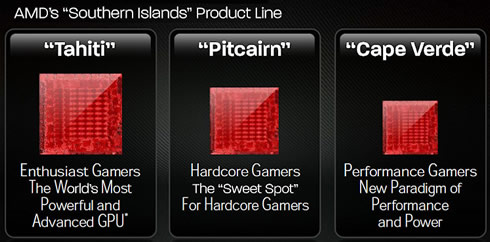

Based on a complete AMD Tahiti GPU, the Radeon HD 7970 has 2048 stream processors organized according to AMD's new SIMD-based GCN architecture. With a 384bit GDDR5 memory bus, the card has 4.31B transistors. Based on TSMC's new 28nm High-K process, the GPU die size is 365mm2, making it a little bit smaller than AMD's 40nm Cayman GPU at 389mm2.
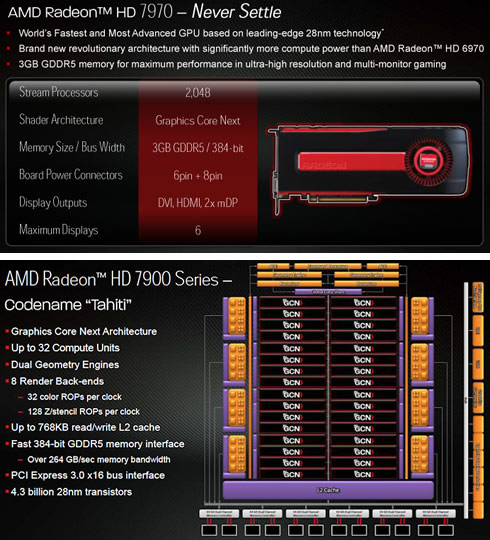
The 7970 is clocked at 925MHz, giving it 3.79TFLOPs of theoretical computing performance compared to 2.7TFLOPs under the much different VLIW4 architecture of the 6970. Its 384bit GDDR5 memory bus for 7970 will be clocked at 1.375GHz (5.5GHz data rate), giving it 264GB/sec of memory bandwidth, a boost over the 176GB/sec of the 6970.
Other elements include 8 ROP partitions that can process 32 ROPs per clock, 128 texture units divided up among 32 Compute Units (CUs), and a fixed function pipeline that contains a pair of AMD?s 9th generation geometry engines.

Let's have a look at other features of AMD's first Southern Island CPU.
By taking advantage of AMD's Accelerated Parallel Processing (App) technology on the AMD Radeon HD 7970, enthusiasts will enjoy improved GPGPU performance, enhanced video quality features through the AMD HD Media Accelerator allowing users to upscale Blu-ray movies, online video and other HD content beyond 1080p resolution.
AMD Eyefinity technology enables gamers and desktop enthusiasts to connect up to six displays to one graphics card, delivering stereoscopic 3D experiences and 16k x 16k display resolutions.
The new card is also armed with the latest PCI Express 3.0 standard and is additionally equipped with GDDR5 memory.
Through its intelligent AMD PowerTune technology the AMD Radeon HD 7970 converts unused power headroom into extra performance by dynamically controlling clock speeds, allowing gamers advanced performance inside of the power envelope they specify. AMD's PowerTune throttling technology will be coming to the entire Southern Islands lineup. This means it remains operationally the same by calculating the power draw of the card based on load, and then altering clockspeeds in order to keep the card below its PowerTune limit. For the 7970 the limit is 250W, with the ability to raise or lower it by 20% in the Catalyst Control Center.

 In addition, the AMD ZeroCore Power
technology found in the AMD Radeon HD 7970 ensures that
no power is wasted when the graphics card is not in
use, enabling lower idle power than any other currently
available graphics card.
In addition, the AMD ZeroCore Power
technology found in the AMD Radeon HD 7970 ensures that
no power is wasted when the graphics card is not in
use, enabling lower idle power than any other currently
available graphics card.
Southern Islands for idle power consumption isn't regular idle, rather it's "long idle, "as it is described by AMD. Long idle is AMD's term for any scenarios where the GPU can go completely idle.
For 7970 AMD has gotten regular idle power usage down to 15W, 5W lower than it was on the 6900 series. AMD's ZeroCore Power is the company's long idle power saving technology. By implementing power islands on their GPUs AMD can now outright shut off most of the functional units of a GPU when the GPU is going unused. By doing this AMD is able to reduce their power consumption from 15W at idle to under 3W in long idle. With support for AMD CrossFire technology, AMD ZeroCore Power eliminates wasted power, as well as additional heat and noise from extra cards when you are not using them.
Discrete Digital Multi-Point (DDM) Audio provides multiple independent audio streams for audio-capable displays via DisplayPort or HDMI signals. It can be very useful in cases where multi-display video conferencing, directional audio or multi-room entertainment hubs are being used.
AMD CrossFire technology coupled with PCI Express 3.0, will allow for increased bandwidth in TriFire and QuadFire configurations.
AMD Eyefinity 2.0 features all-new support for stereo 3D, universal bezel compensation, brand new display configurations and an expanded field of view. This allows users with 2560x1600 monitors in an AMD Eyefinity 5x1 landscape configuration to achieve a horizontal resolution of 12,800 pixels, driving more than 20 million pixels of screen real estate.
AMD claims that the 7970 is going to be good overclocker, with most cards to be able to hit 1GHz or higher on the core clock and 6GHz or higher on the memory clock with little effort even with the reference cooler.
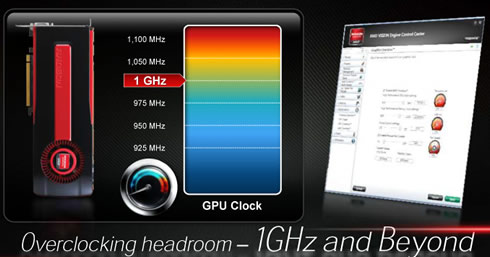
The card also fully supports 3GHz HDMI 1.4a and DisplayPort 1.2 HBR2, ready to drive next generation displays at up to 4K resolution.
The AMD Radeon HD 7970 is also backed by AMD's open 3D initiative for stereo 3D gaming and Blu-ray 3D movies, and fully supports DirectCompute and OpenCL technologies.
Looking at the HD 7970 card, it is 10.5" going by the PCB, but AMD has a metal reinforcement ring/plate running along the entire card that sticks out the rear. After accounting for this plate the total length of the card is just 11", making the card roughly half an inch longer than the 6970 and 5870.
AMD has also made some changes to the shrouding to improve cooling. Compared to the 6970, 7970's blower is a bit larger (~75mm) and the fins are slightly larger to make use of that space. Meanwhile the heatsink is very similar to the 6970's.
The PCIe power sockets are the same 6+8pin configuration as the 6970. Elsewhere at the front end of the card we'll find the two CrossFire connectors, supporting up to 3-way CrossFiree.
Back to the front of the card the is a single DL-DVI port, along with an HDMI port and 2 miniDP ports all along a single slot.
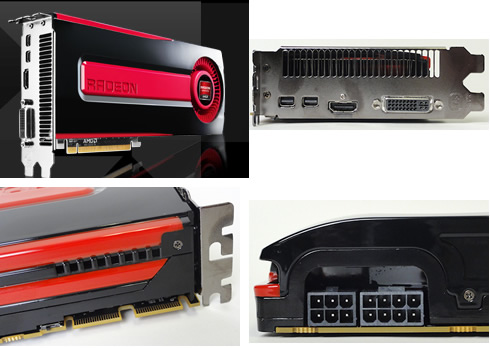
The AMD Radeon HD 7970 is available January 9, 2012 from retailers worldwide, with select models starting at $549 US SEP.
According to the first reviews of the new card, the 7970 is around 15-25% faster than the GTX 580 but not always, as its advantage is highly game dependent. However, with the launch for AMD's Graphics Core Next architecture, AMD has laid out a plan to seriously break into the GPU computing market, taking on Nviddia' Fermi architecture.


Based on a complete AMD Tahiti GPU, the Radeon HD 7970 has 2048 stream processors organized according to AMD's new SIMD-based GCN architecture. With a 384bit GDDR5 memory bus, the card has 4.31B transistors. Based on TSMC's new 28nm High-K process, the GPU die size is 365mm2, making it a little bit smaller than AMD's 40nm Cayman GPU at 389mm2.

The 7970 is clocked at 925MHz, giving it 3.79TFLOPs of theoretical computing performance compared to 2.7TFLOPs under the much different VLIW4 architecture of the 6970. Its 384bit GDDR5 memory bus for 7970 will be clocked at 1.375GHz (5.5GHz data rate), giving it 264GB/sec of memory bandwidth, a boost over the 176GB/sec of the 6970.
| AMD GPU Specification Comparison | ||||||
| AMD Radeon HD 7970 | AMD Radeon HD 6970 | AMD Radeon HD 6870 | AMD Radeon HD 5870 | |||
| Stream Processors | 2048 | 1536 | 1120 | 1600 | ||
| Texture Units | 128 | 96 | 56 | 80 | ||
| ROPs | 32 | 32 | 32 | 32 | ||
| Core Clock | 925MHz | 880MHz | 900MHz | 850MHz | ||
| Memory Clock | 1.375GHz (5.5GHz effective) GDDR5 | 1.375GHz (5.5GHz effective) GDDR5 | 1.05GHz (4.2GHz effective) GDDR5 | 1.2GHz (4.8GHz effective) GDDR5 | ||
| Memory Bus Width | 384-bit | 256-bit | 256-bit | 256-bit | ||
| Frame Buffer | 3GB | 2GB | 1GB | 1GB | ||
| FP64 | 1/4 | 1/4 | N/A | 1/5 | ||
| Transistor Count | 4.31B | 2.64B | 1.7B | 2.15B | ||
| Manufacturing Process | TSMC 28nm | TSMC 40nm | TSMC 40nm | TSMC 40nm | ||
| Price | $549 | $350 | $160 | - | ||
Other elements include 8 ROP partitions that can process 32 ROPs per clock, 128 texture units divided up among 32 Compute Units (CUs), and a fixed function pipeline that contains a pair of AMD?s 9th generation geometry engines.

Let's have a look at other features of AMD's first Southern Island CPU.
By taking advantage of AMD's Accelerated Parallel Processing (App) technology on the AMD Radeon HD 7970, enthusiasts will enjoy improved GPGPU performance, enhanced video quality features through the AMD HD Media Accelerator allowing users to upscale Blu-ray movies, online video and other HD content beyond 1080p resolution.
AMD Eyefinity technology enables gamers and desktop enthusiasts to connect up to six displays to one graphics card, delivering stereoscopic 3D experiences and 16k x 16k display resolutions.
The new card is also armed with the latest PCI Express 3.0 standard and is additionally equipped with GDDR5 memory.
Through its intelligent AMD PowerTune technology the AMD Radeon HD 7970 converts unused power headroom into extra performance by dynamically controlling clock speeds, allowing gamers advanced performance inside of the power envelope they specify. AMD's PowerTune throttling technology will be coming to the entire Southern Islands lineup. This means it remains operationally the same by calculating the power draw of the card based on load, and then altering clockspeeds in order to keep the card below its PowerTune limit. For the 7970 the limit is 250W, with the ability to raise or lower it by 20% in the Catalyst Control Center.

 In addition, the AMD ZeroCore Power
technology found in the AMD Radeon HD 7970 ensures that
no power is wasted when the graphics card is not in
use, enabling lower idle power than any other currently
available graphics card.
In addition, the AMD ZeroCore Power
technology found in the AMD Radeon HD 7970 ensures that
no power is wasted when the graphics card is not in
use, enabling lower idle power than any other currently
available graphics card.
Southern Islands for idle power consumption isn't regular idle, rather it's "long idle, "as it is described by AMD. Long idle is AMD's term for any scenarios where the GPU can go completely idle.
For 7970 AMD has gotten regular idle power usage down to 15W, 5W lower than it was on the 6900 series. AMD's ZeroCore Power is the company's long idle power saving technology. By implementing power islands on their GPUs AMD can now outright shut off most of the functional units of a GPU when the GPU is going unused. By doing this AMD is able to reduce their power consumption from 15W at idle to under 3W in long idle. With support for AMD CrossFire technology, AMD ZeroCore Power eliminates wasted power, as well as additional heat and noise from extra cards when you are not using them.
Discrete Digital Multi-Point (DDM) Audio provides multiple independent audio streams for audio-capable displays via DisplayPort or HDMI signals. It can be very useful in cases where multi-display video conferencing, directional audio or multi-room entertainment hubs are being used.
AMD CrossFire technology coupled with PCI Express 3.0, will allow for increased bandwidth in TriFire and QuadFire configurations.
AMD Eyefinity 2.0 features all-new support for stereo 3D, universal bezel compensation, brand new display configurations and an expanded field of view. This allows users with 2560x1600 monitors in an AMD Eyefinity 5x1 landscape configuration to achieve a horizontal resolution of 12,800 pixels, driving more than 20 million pixels of screen real estate.
AMD claims that the 7970 is going to be good overclocker, with most cards to be able to hit 1GHz or higher on the core clock and 6GHz or higher on the memory clock with little effort even with the reference cooler.

The card also fully supports 3GHz HDMI 1.4a and DisplayPort 1.2 HBR2, ready to drive next generation displays at up to 4K resolution.
The AMD Radeon HD 7970 is also backed by AMD's open 3D initiative for stereo 3D gaming and Blu-ray 3D movies, and fully supports DirectCompute and OpenCL technologies.
Looking at the HD 7970 card, it is 10.5" going by the PCB, but AMD has a metal reinforcement ring/plate running along the entire card that sticks out the rear. After accounting for this plate the total length of the card is just 11", making the card roughly half an inch longer than the 6970 and 5870.
AMD has also made some changes to the shrouding to improve cooling. Compared to the 6970, 7970's blower is a bit larger (~75mm) and the fins are slightly larger to make use of that space. Meanwhile the heatsink is very similar to the 6970's.
The PCIe power sockets are the same 6+8pin configuration as the 6970. Elsewhere at the front end of the card we'll find the two CrossFire connectors, supporting up to 3-way CrossFiree.
Back to the front of the card the is a single DL-DVI port, along with an HDMI port and 2 miniDP ports all along a single slot.

The AMD Radeon HD 7970 is available January 9, 2012 from retailers worldwide, with select models starting at $549 US SEP.
According to the first reviews of the new card, the 7970 is around 15-25% faster than the GTX 580 but not always, as its advantage is highly game dependent. However, with the launch for AMD's Graphics Core Next architecture, AMD has laid out a plan to seriously break into the GPU computing market, taking on Nviddia' Fermi architecture.





















